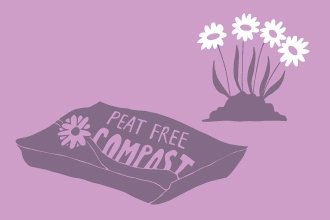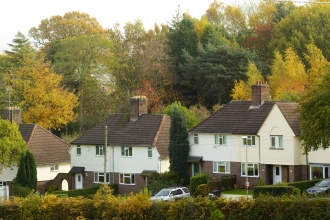What is peat?
You might recognise peat from the dark black compost you used to buy from garden centres. Many people don’t realise that this carbon-rich soil comes from some of our rarest and most nature-rich habitats. That’s why things are changing and many garden centres are making their compost peat free.
It’s not just compost that is threatening them. As our towns and cities grow, many peatlands are at risk of being developed. That’s why we, and so many others, are campaigning to save them.
Why are peatlands important for climate change?
Peat is made up of special water-absorbing mosses called sphagnum. These mosses love the wet and acidic conditions of our peatlands. As the mosses grow, they take in carbon dioxide from our atmosphere and lock it away in their pants cells.
Normally, when a plant dies, the carbon stored within will slowly make its way back into the atmosphere as bacteria break it down. Peatlands, however, stop this from happening. The wet and acidic nature of the peat means that the dead mosses can never fully break down. It’s the same process we use to pickle vegetables when we want to preserve them.
Each year, a new layer of peat is added on top of all the others. As long as the peat stays wet, this process will keep happening, locking away more and more carbon.
Peatlands help to alleviate flooding, by slowing the flow of water and filter water, making it cleaner when it comes to our water processing plants - and eventually into our taps, with 70% of drinking water coming from upland areas dominated by peat.
What do we want to see for our peatlands?
It takes 1,000 years for just one meter of peat to form so, once peat is destroyed, it takes a long time to get it back. We want to see all of our peatlands thriving so they can help us tackle climate change and provide fantastic habitat for wildlife.
All peatlands extraction is stopped
-
Peatlands should no longer be destroyed and peat-based products should no longer be made or sold. Legislation should be introduced to enforce this.
All development on peatlands is stopped
-
All peatland sites must be removed from Local Plans and councils should have a policy against developing peatlands. National planning policy should be updated to advise against developing peatlands.
All peatlands are restored
-
80% of the UK’s peatlands are damaged but we want all peat soils, no matter how damaged, to be brought back in healthy condition. Funding should be provided to enable these restoration projects.
All peatlands are protected
-
No matter what the land it currently used for, it should be listed as irreplaceable habitat to give it a higher level of protection.
All peatlands are valued
-
Many peatlands provide access to nature near to our towns and cities. Accessibility of these sites should be improved to allow people to benefit from having a close connection to nature.
Why are peatlands good for wildlife?
Peatlands in the UK are great for wildlife for several reasons! Imagine them as super special places for plants and animals.
Boggy Homes: Peatlands are like cozy homes for many animals and plants. Birds like curlews and ducks love nesting there. And some unique insects, like dragonflies, hang out around peat bogs.
Soggy Sponge: Peat acts like a sponge. It soaks up rainwater and then slowly releases it. This helps prevent floods and keeps rivers happy, which is super important for creatures who live in and around water.
Carbon Heroes: Peatlands are like Earth's carbon heroes. They store lots of carbon, like a big carbon locker. When peatlands are healthy, they help fight climate change by keeping carbon out of the air.
Colorful Plants: You can find some really cool plants on peatlands, like colorful mosses and unique flowers. They add a splash of color to the landscape.
Mysterious History: Some peatlands are really old, like thousands of years old! They hold secrets about the past, like ancient tools and even people from long ago.
Peatlands are like a natural wonderland for wildlife, help with water, save the planet from too much carbon, and hold stories from the past. They're super important to protect! 😊








